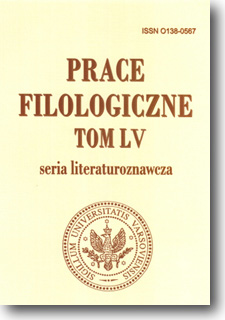Sienkiewiczowskie wyobrażenie kresów
Sienkiewicz’s Imagery of the Borderlands
Author(s): Tadeusz BujnickiSubject(s): Language and Literature Studies
Published by: Wydział Polonistyki Uniwersytetu Warszawskiego
Keywords: literatura polska; Kresy; Henryk Sienkiewicz; Polish literature; Kresy (the Eastern Borderlands); Henryk Sienkiewicz
Summary/Abstract: Sienkiewicz did not refer to the term “kresy” very often. The earliest mention of this expression comes from his review of Spasowicz’s lectures, where he argues in favour of Wincenty Pol and the Polish borderland myth presented in {Mohort}. In literary terms, the exploration of the borderland territory pertained to the short story entitled {Tartarian captivity}. Sienkiewicz’s Borderlands are most of all a vital part of the former Polish-Lithuanian Commonwealth, the world “lost” as a result of the partitions. In this sense the myth of the Borderlands acquires a historical meaning and becomes a part of the patriotic ideology of the writer. The Borderlands are also the frontiers of a great historical (martial) vast steppes adventure. This fictitious adventure takes place in the writer’s imagination as a reconstruction of the Romantic tradition and a modification of the myth of the Wild West, described by Sienkiewicz in his {Letters from the Journey to America}. According to Kazimierz Wyka the American Wild West becomes in the Letters the historic “Wild Fields”. The most complete realization of Sienkiewicz’ idea of the Borderlands may be found in the first and the last part of his Trilogy. In {With Fire and Sword} the events happen in the Ukrainian frontier forming a war sequence, with the siege of the Borderlands stronghold of Zbaraz˙ as the climax. It seems worth drawing attention to the fact that Sienkiewicz’s novels are not anti-Ukrainian, yet they oppose the partitions. The presence of invading Tartar hordes may be considered a prefiguration of the future occupational aggression of the Russian Empire. The same observation pertains to the description of the war strife with Turkey, where Kamieniec Podolski has an analogical function to Zbaraz˙ in the previous case. By contrast, Sienkiewicz’s treatment of the Northern Borderland - Grand Duchy of Lithuania - is different. In {The Deluge} the nobility manor is a place of the tenacious unfading of patriotic ethos. Lithuania is not as much Borderland as Ukraine is, Lithuania is more “Polish”. Sienkiewicz treats the territories of former Poland as a unity, in which various nationalities are simply children “eiusdem matris”. This element of immanent integrity draws attention to the close ties between Poles, Rusyns, and Lithuanians, and explains his depiction of Chmielnicki Uprising as a rebellion, a civil war, in fact an intestine conflict. It seems that his future idealwould be a Republic of Poland based on a federation, whose core would remain Polish, formed by the Polish nation and culture. These assumptions explain why Sienkiewicz opposed any desintegration - the national-liberation movements of Ukraine and Lithuania.
Journal: Prace Filologiczne
- Issue Year: 2008
- Issue No: 55
- Page Range: 217-228
- Page Count: 12
- Language: Polish

